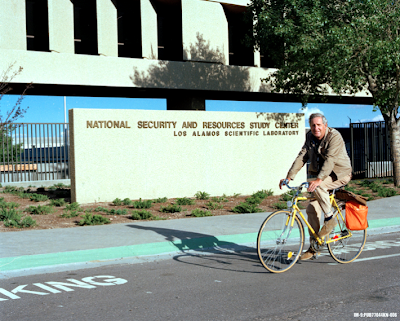10-31-13 Addenum: First ice of the year out there, including some along Diamond at TA-3 and some hard to see ice in the San I roundabout. Be careful out there.
Bob Mionske on lighting here at Bicycling.com
Since even Congress can't create light indefinitely, Sunday means we turn the clocks back and thus this Monday will greet our home commute with some serious darkness. Make sure you have dug out and tested your lighting systems and found your reflective gear. Reflection below the waist, where a car's low beam headlights shine, and preferably on something like the ankle that rotates with pedal stroke, works best. Good lighting is getting cheaper and brighter as technology improves, so seeing your way down the road without accidentally finding a log bounced out the back of a pickup truck or a fresh pothole is getting easier all the time. This obviously applies to sidewalk or path cyclists, too. Several years ago a lightless cyclist hit a friend of mine's wife who was walking on a multiuse path, injuring her severely. Choose your light according to your riding style and budget. Speed, along with legal requirements below, determine optimal light output, since you need to see far enough ahead to react to a situation before it encounters you. You also need to be seen by motorists and others sharing the public space with you.
Note: County code says this about lights and reflectors:
Sec. 38-547.
Lamps and other equipment on bicycles.

(a) Every bicycle when in use at nighttime shall be equipped with a lamp on the front
which shall emit a white light visible from a distance of at least 500 feet to the
front and with a red reflector on the rear of a type approved by the division which
shall be visible from all distances from 50 feet to 300 feet to the rear when directly
in front of lawful upper beams of headlamps on a motor vehicle. A lamp emitting a
red light visible from a distance of 500 feet to the rear may be used in addition
to the red reflector.
My own favorite item, aside from those items already mentioned, are fenders. Mainly to keep crud from coating your lights and reflectors on a potentially grimy day (hence making you invisible), as well as to keep the subfreezing brine off of yourself. Unfortunately, they don't keep brine out of the mechanical bits and I've had my freewheel freeze up on really bad days. Fenders can be a bit of a pill to mount on some disk-brake frames (like the one I ride, shown below) and they can limit your choice of oversize tires (I use cycle cross rubber in winter and studded bike snows should be considered for serious winter riding--go to the link for Peter White's excellent discussion of studded bike snow tires), but hopefully, both bike and fender designs will improve. Since days are short and cold, a heavier bike that takes more effort to go short distances could keep you in better shape. Keep the gossimer plastic fun bike for warm weekend rides, not everyday commutes.
If you don't normally ride with a helmet and consider helmets one of those hot button issues that turn normally rational people into raging lunatics, you might still consider wearing one for winter riding. Winter means cold and darkness, which means more chances to hit ice, roadway obstructions you would normally see clearly by the light of day, or could mean not being seen by the bozo making the right on red. As Andy Cline over at Carbon Trace and I apparently agree, there are risk-elevating factors, including some of these, that argue for more personal protection, not less. Plus, you have an option to add an auxiliary light to that helmet and point it where you want to see while the bicycle mounted light points where your handlebars are headed. I use my helmet light to give a heads up to people at side streets, as added forward illumination at high speeds, and to watch for suicidal coyotes and deer bounding out of the golf course and onto Diamond Drive as I spin downhill towards a cold beer in the North Mesa fridge at over 30 mph. One concern, though, is something on the helmet that can catch and twist the head in a crash. My helmet mount for my Light and Motion light has a quick breakaway attachment. Some further thoughts on helmet mounted lights are here at BHSI. Mind you, a helmet doesn't make a klutz safe on a snowy ride home nor does it ward off evil spirits. Competent riding, making good choices, and maintaining situational awareness are your best defenses against mishaps.
 |
| Helmet Mounted Light Without breakaway mount. Hmmm. |
I'll leave clothing opinions out of this for the most part. One thing to keep in mind is that you do work up some body heat when riding with any effort, so make your clothing choices on the basis of your riding style, not mine. Ears, hands, and feet get cold fast and you lose a lot of heat through the scalp, so pay attention to those parts. REI, the online bike stores, your local bike shops, and CB Fox have good technical wear available. There is a new brick and mortar multisport shop opening on Central Ave across from Starbucks, but I've not checked them out.
Add any suggestions for winter commuting to the comments. Hopefully anyone with serious questions can find someone to answer them here, at the safety page at LANL, on the Web, or at the Local Bike Shoppe.













